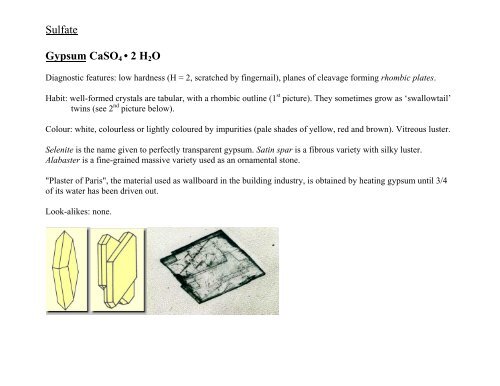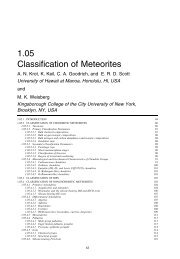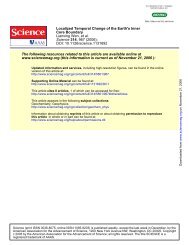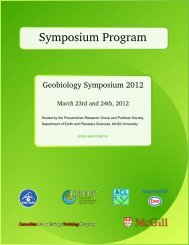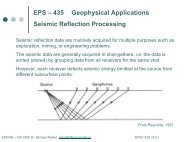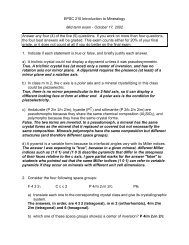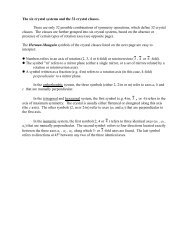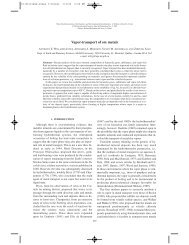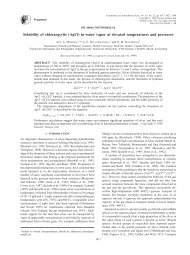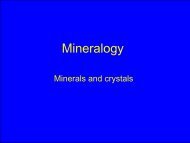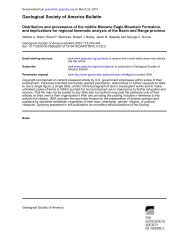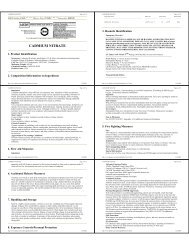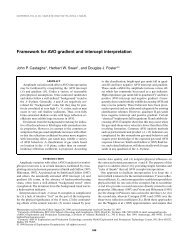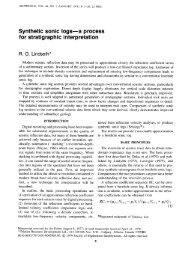Mineral Sheets compi..
Mineral Sheets compi..
Mineral Sheets compi..
Create successful ePaper yourself
Turn your PDF publications into a flip-book with our unique Google optimized e-Paper software.
Sulfate<br />
Gypsum CaSO 4 • 2 H 2 O<br />
Diagnostic features: low hardness (H = 2, scratched by fingernail), planes of cleavage forming rhombic plates.<br />
Habit: well-formed crystals are tabular, with a rhombic outline (1 st picture). They sometimes grow as ‘swallowtail’<br />
twins (see 2 nd picture below).<br />
Colour: white, colourless or lightly coloured by impurities (pale shades of yellow, red and brown). Vitreous luster.<br />
Selenite is the name given to perfectly transparent gypsum. Satin spar is a fibrous variety with silky luster.<br />
Alabaster is a fine-grained massive variety used as an ornamental stone.<br />
"Plaster of Paris", the material used as wallboard in the building industry, is obtained by heating gypsum until 3/4<br />
of its water has been driven out.<br />
Look-alikes: none.
Sulfate<br />
Barite BaSO 4<br />
Diagnostic features: noticeably high specific gravity (G = 6.55) for a non-metallic mineral, good cleavage.<br />
Habit: single crystals are generally tabular, often with a rhombic cross section.<br />
Cleavage: an excellent basal (001) cleavage and a good prismatic (210) cleavage with rhombic cross section. The<br />
basal cleavage is perpendicular to the rhombic cleavage so fragments break into plates with rhombic<br />
outlines .<br />
Hardness: 3 - 3.5<br />
Colour: often white but can be coloured by many impurities.<br />
Look-alikes: difficult to distinguish in hand specimens from witherite and celestine, two other less common<br />
sulfates with a similar structure and physical properties.<br />
Barite typically forms in hydrothermal conditions, i.e. it precipitates from hot underground waters, and is often<br />
associated with fluorite and calcite (or other rhombohedral carbonates).
Native element<br />
Silver Ag<br />
Diagnostic features: silvery, metallic luster on fresh surfaces (silver tarnishes quickly to brown or gray-black).<br />
High specific gravity (G = 10.5).<br />
Cleavage: none.<br />
Hardness: 2.5 - 3. Malleable, ductile.<br />
Habit: crystals are usually malformed, as irregular masses, plates and scales. Sometimes found as wires or<br />
arborescent (dendritic) groups.<br />
Look-alikes: other silver-coloured sulfides or sulfosalts (arsenopyrite, skutterudite) are brittle and have a lower<br />
specific gravity.
Native element<br />
Copper Cu<br />
Diagnostic features: distinctive metallic luster and reddish-orange colour on fresh surfaces. Tarnishes to dark<br />
brown colour.<br />
Cleavage: none. Malleable, with a hackly fracture.<br />
Hardness: 2.5 - 3<br />
Habit: crystals are usually malformed, often in branching and arborescent groups.<br />
Look-alikes: nickeline (close in colour but harder).
Native element<br />
Graphite C<br />
Diagnostic features: dark gray, metallic to dull luster, greasy feel, soft enough to soil the fingers, unusually low<br />
specific gravity (G = 2.23).<br />
Habit: rarely well crystallized, hexagonal plates and, less commonly, spherulites.<br />
Colour: dark gray (slightly brown in comparison to molybdenite). Streak: dark gray to black.<br />
Hardness (1-2, easily soils the fingers).<br />
Cleavage: perfect {0001} basal cleavage is rarely visible because the crystals are small or easily deformed.<br />
Look-alikes: Molybdenite. Graphite's gray colour is closer to beige while molybdenite’s gray has a bluish tinge.<br />
Also, be sure to compare their streak. Molybdenite has a greenish black streak.
Sulfide<br />
Molybdenite MoS 2<br />
Diagnostic features: metallic luster, lead-gray colour with a bluish tone, soft and almost malleable (can be flaked<br />
with the fingernail).<br />
Hardness: 1-1.5<br />
Cleavage: {0001} perfect basal cleavage on tabular hexagonal crystals.<br />
Habit: hexagonal plates or short prisms. Often massive, commonly foliated.<br />
Look-alike: its greenish gray streak, and the bluish tone of its lead-gray colour distinguishes molybdenite from<br />
graphite's dark gray streak. Compare them carefully.
Sulfide<br />
Chalcopyrite CuFeS 2<br />
Diagnostic features: deep brass-yellow colour, often tarnished in places to other colours (orange, purple, bluish).<br />
Habit: crystals are rare but when well-formed they are tetrahedra. Striations, if present, form triangles on faces.<br />
Colour: deep brass-yellow colour, with a greenish black streak.<br />
Hardness: 3.5-4 (easily scratched by knife but not by fingernail).<br />
Look-alikes: distinguished from pyrite by its deeper yellow colour, iridescent tarnish and lower hardness. Its<br />
tarnish resembles bornite's but their colour on broken fresh surfaces is different. Distinguished from gold<br />
by its brittle nature, deeper yellow, and much lower density.<br />
This copper sulfide is common, but is generally not a rich enough ore to be mined. However, hot waters from<br />
geothermal systems leach away copper from chalcopyrite, and re-deposit it as cuprite (Cu 2 O) or native copper.
Sulfide<br />
Pyrrhotite Fe 1-x S<br />
Habit: pyrrhotite rarely forms good crystals, and is more commonly seen in massive aggregates. Under the<br />
microscope, however, it may occur as (or contain) exsolution blebs and lamellae consisting of pentlandite<br />
(Fe,Ni) 9 S 8 , an important ore of Ni.<br />
Colour: brownish bronze, metallic luster, black streak.<br />
Hardness: 4<br />
Look alikes: pyrrhotite is close in colour and tarnish to chalcopyrite, but compare their streaks (pyrite and<br />
chalcopyrite have greenish black streaks). Pyrrhotite is also the only common ore mineral, with magnetite, to<br />
display magnetism. Its magnetism, though not as strong as that of magnetite, often helps to distinguish pyrrhotite<br />
from other yellow sulfides.
Sulfide<br />
Galena PbS<br />
Diagnostic features: high specific gravity, gray colour, metallic luster and cubic cleavage.<br />
Habit: usually cubic (left, below), but may be modified by octahedra (right, below). The cubic cleavage (center,<br />
below) is often visible as broken sharp corners in coarse-grained aggregates.<br />
Colour: the lead gray colour of the mineral matches the colour of its streak.<br />
Hardness: 2.5 (very easy to streak)<br />
Look-alikes: stibnite when massive, but the cubic cleavage of galena is usually diagnostic. Galena is the more<br />
common of these two sulfides.
Sulfide<br />
Pyrite FeS 2<br />
Diagnostic features: pale brass yellow colour, relatively high hardness, streak is greenish to brownish black.<br />
Habit: crystals are often cubic, and usually striated (one direction on each face). Pyrite can also adopt other regular<br />
forms like octahedra and dodecahedra, and some crystals combine two or three forms. Poor cleavage.<br />
Colour: pale brass yellow (deeper if tarnished) and metallic luster.<br />
Hardness: 6 (unusually high for a sulfide mineral).<br />
Look-alikes: massive chalcopyrite and other yellow sulfides are easily confused with massive pyrite until your eye<br />
becomes attuned to their distinctly different colours and hardness.<br />
This is the most common sulfide, found in sedimentary, metamorphic and igneous rocks as well as hydrothermal<br />
deposits. It is often found with other sulfides.
Phyllosilicate<br />
Talc Mg 3 Si 4 O 10 (OH) 2<br />
Diagnostic features: low hardness (1: softest on Moh’s scale, scratched by fingernail),<br />
soapy feel and pearly luster.<br />
Habit: crystals are rare. Found most commonly in foliated or compact masses. When talc separates in plates, the<br />
plates are not elastic, i.e. that once it has been bent, the plate does not snap back.<br />
Colour: white, gray or greenish. Its luster is non-metallic and often described as pearly or silky.<br />
Look-alikes: Serpentine and fine grained muscovite (sericite).<br />
Soapstone, used for carving, is a rock largely made of compact, fine-grained talc.
Phyllosilicate<br />
Muscovite KAl 2 (AlSi 3 O 10 )(OH) 2<br />
Muscovite is also called white mica and potash mica.<br />
Diagnostic features: micaceous habit; perfect platy cleavage; coloured in thick blocks but colourless and<br />
transparent in thin sheets. Low hardness (2-2.5).<br />
Habit: monoclinic, but euhedral crystals are rare and their cross-section is orthorhombic or hexagonal. Most<br />
commonly occurs in scales or sheets without any regular form, simply filling space between surrounding<br />
minerals. It sometimes occurs as compact masses of minute scales known as sericite, which is an alteration<br />
product of potassic feldspar.<br />
Colour: transparent and colourless in thin sheets. Thicker plates are commonly smoky brown but they may also be<br />
pink, yellow or green.<br />
Look-alikes: muscovite is far more common than phlogopite, the colorless magnesian mica.
Inosilicate<br />
Amphiboles (double-chain silicates)<br />
Hornblende NaCa 2 (Mg, Fe, Al) 5 (Si, Al) 8 O 22 (OH) 2<br />
Diagnostic features: moderate hardness (5-6: barely scratched by a knife), perfect prismatic<br />
cleavage (two planes at angles of 124° and 56°) which gives a “splintery” look to its broken<br />
surfaces. Usually found as prismatic crystals, dark green to black.<br />
Habit: prismatic crystals with a six-sided, nearly rhombic cross section.<br />
Colour: dark green to black. Vitreous luster.<br />
Streak: white (unless the mineral contains small inclusions of opaque oxide minerals).<br />
Look-alikes: augite.<br />
Hornblende is the most common of the amphiboles and occurs in a variety of igneous rocks.<br />
orientation of the 2 cleavage planes
Inosilicate<br />
Amphiboles (double-chain silicates)<br />
Tremolite Ca 2 Mg 5 Si 8 O 22 (OH) 2 - Actinolite Ca 2 Fe 5 Si 8 O 22 (OH) 2<br />
Diagnostic features: moderate hardness (5-6: barely scratched by a knife), perfect prismatic<br />
cleavage (with angles of 124° and 56°) gives a “splintery” look to broken surfaces. Found in<br />
prismatic crystals, sometimes bladed. Colour varies with iron content.<br />
Colour: Pure tremolite is white but even a small amount of iron may give it a greenish tinge. The green colour of<br />
pure actinolite is so dark that the crystals looks black. Luster is generally vitreous but some varieties are<br />
fibrous.<br />
Habit: Slender bladed prisms or fibrous radiating bunches.<br />
Cleavage: Obvious parallel to their lengths; the two sets intersect at nearly 120º on basal sections<br />
Look-alikes (Actinolite): Hornblende.<br />
Look-alikes (Tremolite): Anthophyllite, sillimanite and wollastonite.
Inosilicate<br />
Pyroxenes (single-chain silicates)<br />
Augite (Ca,Na)(Fe,Mg,Al)(Al,Si) 2 O 6<br />
Diagnostic features: stubby prismatic habit with an octogonal cross-section, moderate hardness (5.5, about same as<br />
a steel blade) and dark colour (deep green to black). Cleavage is imperfect, at angles of 87° and 93°.<br />
Habit: stubby prismatic crystals very similar to those of diopside. The cross section seen perpendicular to the prism<br />
is often eight-sided, because the faces m, a and b in the prism zone make angles of nearly 45° with each<br />
other.<br />
Colour: deep green to black.<br />
Look-alikes: Hornblende, which has a better prismatic cleavage at angles of nearly 60° and 120°.<br />
Augite is one of the most common of the pyroxenes. It occurs mainly in igneous rocks.
Inosilicate<br />
Pyroxenes (single-chain silicates)<br />
series: Diopside CaMgSi 2 O 6 - Hedenbergite CaFeSi 2 O 6<br />
Diagnostic features: prismatic habit, octagonal section, moderate hardness (5.5, about same as knife) and colour<br />
(white to green). Imperfect cleavage, at angles of 87° and 93°. A well-developed parting parallel to the basal<br />
pinacoid c is sometimes visible.<br />
Habit: prismatic crystals are common. The cross section seen perpendicular to the prism is often eight-sided,<br />
because the faces m, a and b in the prism zone make angles of nearly 45° with each other.<br />
Colour: white to green, varying with the amount of Fe present.<br />
Cleavage: prismatic, parallel to the length of the prisms, at angles of 87° and 93°.<br />
Look-alikes: altered or smaller crystals can be mistaken for olivine (lacks good cleavage) and/or augite (usually<br />
darker).
Tectosilicate<br />
Quartz SiO 2<br />
There are several polymorphs of quartz. The most common one is “low-quartz” or “alpha-quartz”.<br />
Diagnostic features: hardness (7: not scratched by knife), prismatic habit, conchoidal fracture, vitreous luster.<br />
Habit: in euhedral (i.e. well-formed) crystals, the dominant form is generally a hexagonal prism with faces showing<br />
horizontal striations. The pointed pyramidal ends are actually two rhombohedra (labeled “r” and “z” on<br />
these drawings). Other minor faces are sometimes present. In anhedral (i.e. without faces) specimens, the<br />
lack of cleavage and hardness are characteristic.<br />
Colour: highly variable, from transparent and colourless to black, with nearly every colour in between! Quartz is<br />
always very pure but minute amounts of certain impurities can give it vivid colours. Some colours can be<br />
modified by irradiation or heating because they are due to the presence of defects in the structure.<br />
The names given to varieties of quartz having specific colours include: amethyst (purple), citrine (yellow), smoky<br />
quartz (dark brown), milky quartz (white). Quartz always leaves a white streak, regardless of its colour.
Nesosilicate<br />
Garnet A 3 B 2 Si 3 O 12<br />
Diagnostic features: high hardness (6.5-7.5, harder than a knife), equant (isometric) habit, vitreous luster, no<br />
distinct cleavage.<br />
Habit: equant, consisting of a dodecahedron, a trapezohedron or a combination of these (shown below).<br />
Colour: highly variable with composition. Many garnets have compositions intermediate between the endmembers<br />
listed below.<br />
Pyrope, Mg 3 Al 2 Si 3 O 12 is usually deep red.<br />
Almandine, Fe 3 Al 2 Si 3 O 12 is red to black.<br />
Spessartine, Mn 3 Al 2 Si 3 O 12 is brownish red to pink.<br />
Grossular, Ca 3 Mg 2 Si 3 O 12 is colourless to yellow, green or brown.<br />
Andradite, Ca 3 Fe 2 Si 3 O 12 is found in shades of yellow, green or brown to black.<br />
Uvarovite Ca 3 Cr 2 Si 3 O 12 has an emerald-green colour.
Nesosilicate<br />
Olivine (Mg,Fe) 2 SiO 4<br />
series: Forsterite Mg 2 SiO 4 - Fayalite Fe 2 SiO 4<br />
NOTE: The use of parenthesis within a chemical formula indicates elements which may be found in variable<br />
proportions within a given mineral structure. In olivine, the silicate tetrahedra are connected by either Mg 2+ or<br />
Fe 2+ cations.<br />
Diagnostic features: hard (6.5-7: harder than knife) but grains are easily detached from the rock; no cleavage but<br />
pronounced conchoidal fracture; colour is green but can tend towards yellow or brown. This mineral is found<br />
mostly in dark-coloured igneous rocks, like the Hawaiian basalts.<br />
Colour: A perfectly pure forsterite would be colourless. The presence of some Fe 2+ in most olivine is responsible<br />
for its green colour. Fe-poor varieties can be yellow, and Fe-rich varieties can be brown. The yellow-green,<br />
gem-quality variety of olivine is known as PERIDOT.<br />
Habit: its stubby prismatic crystals usually look like small grains disseminated through the rock.<br />
Look alikes: epidote, diopside. Unlike epidote, green olivine is not found with quartz. It lacks the twinning and<br />
prismatic cleavage that are commonly seen in diopside.
Cyclosilicate (ring silicate)<br />
Beryl Be 3 Al 2 Si 6 O 18<br />
Diagnostic features: high hardness (7.5-8, harder than quartz and knife), hexagonal<br />
prismatic habit, and a poor platy cleavage.<br />
Habit: hexagonal prisms terminated by a pinacoid (less commonly by dipyramidal faces) are common. Striations<br />
are parallel to the long axis of the prism.<br />
Colour: usually bluish green or light yellow, but it may be emerald green, pink, white or colourless.<br />
Look-alikes: Tourmaline (usually rounded triangular cross section), apatite (softer than quartz).<br />
Various names are given to gem-quality crystals: AQUAMARINE is the clear blue-green variety, coloured by<br />
small amounts of Fe, EMERALD is coloured deep green by chromium or vanadium, MORGANITE is pale pink to<br />
deep rose, and GOLDEN BERYL is clear yellow.
Tectosilicate<br />
Potassic Feldspars Orthoclase/Microcline KAlSi 3 O 8<br />
Diagnostic features: moderately high hardness (6: barely harder than knife), two directions of<br />
cleavage mutually perpendicular (parallel to faces b and c), vitreous luster.<br />
Habit: euhedral crystals have a tabular to prismatic habit.<br />
Colour: variable. Often pinkish or light orange but may also be white, pale yellow, reddish, greenish, or gray. The<br />
variety AMAZONITE has a blue-green colour related to the presence of small amounts of Pb.<br />
Look-alikes: members of the plagioclase series (including albite).<br />
Most feldspars contain sodium as well as potassium and are part of the "alkali feldspar" series orthoclase KAlSi 3 O 8 -<br />
albite NaAlSi 3 O 8 . Once they crystallize from magma, feldspars of intermediate composition undergo a chemical<br />
unmixing if they are allowed to cool slowly (in an intrusive rock, for example). The mineral separates into lighter<br />
and darker veins, giving rise to a characteristic texture called PERTHITE (shown in bottom right corner).<br />
Microcline is the low-temperature version of orthoclase. The bonding angles within their structures are slightly<br />
different (cleavage directions are 89.5° apart in triclinic microcline, but exactly 90° apart in monoclinic orthoclase).<br />
Orthoclase and microcline cannot be told apart in hand specimen. Both names (and their synonym, "K-feldspar")<br />
will be accepted interchangeably on the test.
Phyllosilicate<br />
Chlorite group<br />
Chlorite (Mg, Fe) 3 (Si, Al) 4 O 10 (OH) 2·(Mg, Fe) 3(OH) 6<br />
Diagnostic features: pale green colour appears when scratched, micaceous habit and cleavage, folia are not elastic.<br />
Habit: large crystals are rare. Found most commonly as small scales dispersed in metamorphic rocks, giving them a<br />
greenish colour. The perfect {001} cleavage often makes it easy to detach small platelets by scraping the<br />
rock with the knife. Chlorite is often found as a pseudomorphs of other ferromagnesian silicate minerals,<br />
and the crystals may be submicroscopic. Scratching the specimen will leave a pale green groove.<br />
Colour: various shades of green (pale to nearly black), depending on the relative amounts of Mg and Fe.<br />
Other properties: low hardness (2-2.5: close to fingernail). May be hard to test if small chloride crystals are<br />
dispersed among harder minerals in a rock, or if a thin layer of chlorite covers a much harder mineral.<br />
Look-alikes: Actinolite, talc, serpentine.<br />
Like talc and serpentine, this mineral is a common product of the alteration of other ferromagnesian minerals (e.g.,<br />
olivine, augite, hornblende, actinolite and some garnets among those seen last week). The green colour of many<br />
igneous rocks is due to the alteration to chlorite of the original amphiboles (e.g. hornblende) and/or pyroxenes (e.g.<br />
augite) in these rocks. The green colour of many schists and slates (metamorphic rocks) is due to disseminated<br />
chlorite.
Phyllosilicate<br />
Serpentine group<br />
Chrysotile Mg 3 Si 2 O 5 (OH) 4<br />
BE CAREFUL when handling CHRYSOTILE or ANY FIBROUS MINERAL. Any fibrous mineral will release<br />
microscopic fibers if it is scratched or shaken. Breathing mineral fibers or dust irritates the lung tissues.<br />
Diagnostic features: fibrous to asbestiform habit, greenish colour.<br />
Habit: asbestiform (long, flexible fibers), usually interbedded with other massive minerals of the serpentine group.<br />
(The fibers actually consists of layer-like crystals rolled up like miniature carpets.)<br />
Colour: shades of green, pearly luster.<br />
Hardness: 3-4, but hard to test on asbestiform specimens because the fibers separate so easily.<br />
Look-alikes: other asbestiform minerals.<br />
This is a common alteration mineral of olivine and magnesian pyroxene or amphibole. It is one of the minerals<br />
called "asbestos" (a general term for fibrous silicate minerals used in industry for fire- and earthquake-proofing<br />
materials), but probably the least harmful of them all because the fibers can dissolve in the lung fluids.
Tectosilicate<br />
sodic end-member of the Plagioclase series<br />
Albite NaAlSi 3 O 8<br />
Diagnostic features: moderately high hardness (6: barely harder than knife), two directions of cleavage mutually<br />
perpendicular (parallel to faces b and c), vitreous luster, striations due to polysynthetic<br />
twinning.<br />
Habit: euhedral crystals have a tabular to prismatic habit. The variety cleavelandite displays very thin, platy, white<br />
or transparent crystals.<br />
Colour: variable. Albite makes up the lighter-coloured veins of Na-felspar (albite, NaAlSi 3 O 8 ) that often separate<br />
from the darker-coloured K-feldspar (orthoclase or microcline) during its cooling following igneous<br />
crystallization. We already saw that this texture formed by two intergrown feldspar is called PERTHITE.<br />
Look-alikes: Orthoclase, microcline.
Tectosilicate<br />
intermediate member of the Plagioclase series<br />
Labradorite (Na ~.5 ,Ca ~.5 )(Al ~1.5 ,Si ~2.5 )O 8<br />
Diagnostic features: moderately high hardness (6: barely harder than knife), two directions of cleavage mutually<br />
perpendicular (parallel to faces b and c), vitreous luster, striations due to polysynthetic<br />
twinning, dark colour and iridescence visible on {010} (i.e. the faces b).<br />
Habit: euhedral crystals have a tabular to prismatic habit similar to that of albite.<br />
Colour: dark, due to minuscule inclusions of the mineral magnetite. The iridescence is due to the scattering of light<br />
by minuscule lamellae that form during cooling of this feldspar after crystallization. The cause is an<br />
unmixing process (exsolution) of the same type as the one forming perthite in microcline. Here, the<br />
unmixing gives rise to lamellae of Ca-rich feldspar (anorthite) in a Na-rich feldspar (albite), or vice-versa.
Sulfide<br />
Sphalerite ZnS<br />
Diagnostic features: moderate hardness (H = 3.5-4), many planes of cleavage, resinous luster.<br />
Habit: well-formed tetrahedral crystals (left, below) are rare. They cleave into dodecahedra (6 cleavage planes,<br />
below right). Even in aggregates, the many cleavage planes give a “sparkling” appearance to the specimen.<br />
Colour: colourless when pure but generally yellow to brownish, sometimes black. The streak is colourless in pure<br />
sphalerite and its colour is yellow to brown with increasing Fe content.<br />
Look-alikes: none, really. Hematite can be as sparkly but its streak is darker and slightly reddish.<br />
Sphalerite is the most common zinc mineral and it forms in hydrothermal vein systems, often with galena and other<br />
sulphides. The structure of sphalerite is a derivative of diamond's but its overall symmetry is lower because two<br />
different ions are in tetrahedral coordination.
Native element<br />
Sulfur S<br />
Diagnostic features: yellow colour, characteristic smell.<br />
Habit: usually found as incrustations or irregular masses that are imperfectly crystallized. When well formed the<br />
crystals are orthorhombic and dipyramidal.<br />
Colour: yellow (but colour can tend towards orange or greenish when impurities substitute for S).<br />
Hardness: 1.5-2.5<br />
Look-alikes: none.<br />
Note : Most of the specimens in your drawers are not examples of natural sulfur. They are chunks of the massive<br />
microcrystalline sulfur that is extracted from most oil or natural gas before they are sold as fossil fuels. If left in oil<br />
or gas, this sulfur would react with oxygen to form a serious atmospheric pollutant.
Carbonate (rhombohedral, calcite structure)<br />
Dolomite CaMg(CO 3 ) 2<br />
Diagnostic features: rhombohedral cleavage, little reaction with HCl at room temperature (more soluble if the<br />
mineral is powdered), often slightly rusty on weathered surface.<br />
Habit: unit rhombohedra are common, sometimes with curved faces (“saddle” dolomite, shown to the right, below).<br />
Perfect rhombohedral cleavage like calcite and other rhombohedral carbonates. Polysynthetic twinning is<br />
common, giving rise to striations along the long diagonal of the rhombic faces.<br />
Colour: white or in shades of flesh or pink.<br />
Hardness: 3.5-4.<br />
Look-alikes: Siderite. Ankerite, CaFe(CO 3 ) 2 , is the name given to Fe-rich varieties of dolomite that are intermediate<br />
in properties and compositioin between dolomite and siderite. Ankerit is typically yellowish to<br />
yellowish-brown, with a weak reaction to HCl similar to that of dolomite.
carbonate (rhombohedral)<br />
Calcite CaCO 3<br />
Diagnostic features: noticeable reaction (effervescence) with HCl at room temperature, rhombohedral cleavage,<br />
moderate hardness (H = 3-3.5).<br />
Habit: highly variable but a three-fold or six-fold symmetry is often clearly visible. Crystals can be nearly acicular<br />
or flattened plates. Most are combinations of rhombohedra and prism(s) or scalenohedra..<br />
Colour: colourless when pure, but highly variable because of the presence of fluid inclusions, organic matter,<br />
inclusions of other minerals or substitution of Ca 2+ ions by various impurities.<br />
Cleavage fragments of limpid, colourless calcite crystals displays pronounced double<br />
refraction. There is no double refraction if one looks through the crystal down its c<br />
axis.<br />
Calcite and aragonite are polymorphs of calcium carbonate.
Phosphate<br />
Apatite Ca 5 (PO 4 ) 3(F, Cl, OH)<br />
Diagnostic features: hexagonal prismatic habit, moderate hardness (H = 5). Habit is similar to beryl but it is soft<br />
enough to be easily scratched by a knife.<br />
Habit: well-formed hexagonal prisms are common. Poor cleavage. Fractures perpendicular to length are<br />
common.The crystal faces are often corroded by dissolution following crystallization.<br />
Colour: variable. Reddish-brown and green are common, sometimes in the same crystal.<br />
Hardness: 5 (scratched by knife but not by fingernail).<br />
Look-alikes: other hexagonal prismatic minerals such as beryl, tourmaline or corundum are much harder.<br />
This fairly common mineral is found as accessory in igneous rocks, metamorphic rocks and hydrothermal deposits.<br />
It also makes up most of your bones and teeth. The fluorine-rich apatite (fluorapatite) is noticeably harder and<br />
more resistant to dissolution by acid than the other two. This is why the fluoridation of water and toothpaste is<br />
generally considered to contribute to dental health.
Halide<br />
Halite NaCl<br />
Diagnostic features: low hardness (H = 2.5, scratched by a tough fingernail), perfect cubic cleavage, salty taste.<br />
Habit: crystals are usually cubic. “Hopper-shaped” skeletal crystals grow from rapidly evaporating solutions.<br />
Colour: colourless when pure. Often white because of inclusions (small bubbles filled with fluid that were trapped<br />
during crystal growth) or coloured by impurities or inclusions of other minerals.<br />
Look-alikes: Sylvite tastes more bitter.<br />
The structure of halite, NaCl, and sylvite, KCl, are identical. Both minerals are less dense (G = 2-2.1) than most<br />
non-metallic minerals. They are part of a sequence of minerals commonly formed by evaporation of seawater:<br />
aragonite or calcite → gypsum → halite → sylvite.
Oxide Already have slide in week 8<br />
Corundum Al 2 O 3<br />
Diagnostic features: vitreous luster, often with rhombohedral parting. The parting and/or growth features often<br />
produce triangular patterns on the basal parallelohedron {0001}. Its high hardness (H = 9) is somewhat misleading<br />
because the surface of corundum easily alters to a much softer mica, and can only be observed on a freshly broken<br />
surface.<br />
Habit: crystals are six-sided, in prismatic columns or tabular.<br />
Colour: colourless when pure, but quite variable when impurities are present. Sapphire is coloured blue by electron<br />
transfers between trace amounts of Fe 2+ and Ti 4+ . Ruby is coloured red by trace amounts of Cr 3+ .<br />
This mineral has exactly the same structure as hematite but the strength of the Al-O bond gives it a much higher<br />
hardness. The six-sidedness of the crystals reflects the hexagonal close-packing of the oxygen ions.
Halide<br />
Fluorite CaF 2<br />
Diagnostic features: octahedral cleavage, moderate hardness (H = 4, easily scratched by the knife), cubic habit.<br />
Habit: usually cubes, sometimes modified by octahedra. Often found in aggregates of interpenetrating crystals.<br />
Colour: very variable, the mineral is coloured by a wide range of impurities substituting for the Ca 2+ ions.<br />
Cleavage: perfect, octahedral {111}.<br />
Look-alikes: None when its habit and cleavage are distinct.<br />
Most well crystallized fluorite is of hydrothermal origin but it also occurs widely as a disseminated phase in<br />
metamorphic and igneous rocks.<br />
The phenomenon of fluorescence received its name because it was observed early in some varieties of fluorite. Not<br />
all fluorite, however, is fluorescent. The property depends on the presence of trace amounts of rare-earth elements<br />
substituting for the Ca 2+ ions in its structure.<br />
Avoid pouring dilute HCl on fluorite samples. Dissolving even small amounts of fluorite in an acidic solution can<br />
be quite corrosive to the skin.
Carbonate (rhombohedral, calcite structure)<br />
Siderite FeCO 3<br />
Diagnostic features: rhombohedral cleavage, brown colour, vitreous luster, moderate hardness (H = 3.5-4). Should<br />
barely react to HCl at room temperature.<br />
Habit: crystals are usually simple unit rhombohedra, often with curved faces. Also occurs in compact, granular<br />
masses. Perfect rhombohedral cleavage.<br />
Colour: light to dark brown. Vitreous luster.<br />
Hardness: 3.5-4.<br />
Look-alikes: Dolomite, ankerite.<br />
Siderite is associated with some coal beds and metallic ore deposits of hydrothermal origin. It has been mined as an<br />
ore of iron in Europe.
Oxide Already have slide (probably week8)<br />
Magnetite Fe 3 O 4 ( = Fe 2+ Fe 3+ 2O 4 )<br />
Diagnostic features: strong magnetism, black colour and black streak.<br />
Habit: crystals are rare but are usually octahedral when visible. Magnetite usually occurs in massive aggregates.<br />
Colour: black, with a bright metallic luster on fresh surfaces.<br />
Hardness: 6.<br />
Less abundant than hematite but richer in Fe (and easier to separate economically from the gangue minerals<br />
surrounding it, because of its magnetism), magnetite is an important ore mineral when it occurs in massive<br />
aggregates. It is also rather common as small scattered crystals in many magmatic, metamorphic rocks and<br />
sedimentary rocks. This is the mineral that usually preserves the "remanent magnetism" (fossil magnetic field) of<br />
rocks used to infer the past movements of continents throughout their geological history.
Oxide Already have a slide<br />
Hematite Fe 2 O 3<br />
Diagnostic features: dark reddish streak. The streak is darker in pure specimens (but magnetite may also be<br />
present). The streak is much lighter (reddish brown) when the mineral is dispersed among white-streak minerals.<br />
Habit: crystals are rare but they have a three-sided symmetry (middle photograph, below) which reflects the<br />
hexagonal close packing of the oxygen ions. Also seen in reniform aggregates (below, right). Hematite often coats<br />
other iron-bearing minerals as a weathering product.<br />
Colour: varies from metallic black in larger crystals, to ocher (brownish red) in fine-grained aggregates. Luster<br />
also varies wildly, from metallic on large crystals to dull on fine-grained aggregates.<br />
Hardness: 5.5 - 6.5, but hard to evaluate if small crystals are dispersed in the rock.<br />
This mineral has exactly the same structure as corundum, but consists of Fe 3+ O 6 octahedra. It is an important iron<br />
ore (but not the richest one). Small quantities of magnetite are often associated with hematite, giving some<br />
hematite-rich specimens a slight magnetism. Check both streak and magnetism to recognize hematite-magnetite<br />
mixtures!
Oxide<br />
Ilmenite FeTiO 3<br />
Diagnostic features: distinguished from hematite by a darker streak, black to brownish-red, and from magnetite by<br />
its lack of strong magnetism.<br />
Habit: similar to hematite but rhombohedral crystals are rare and their truncation by basal planes makes them look<br />
tabular. Often in thin plates, or massive and compact. Some black sands are rich in grains of ilmenite.<br />
Colour: iron-black. Streak: black to brownish-red.<br />
Look-alikes: hematite, magnetite, chromite (compare their streaks).<br />
Ilmenite may be weakly magnetic. It is a common accessory mineral in igneous rocks and vein deposits.<br />
Its structure is identical to that of corundum and hematite, with alternating layers of FeO 6 and TiO 6 octahedra<br />
sharing edges and faces.


